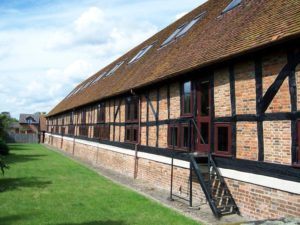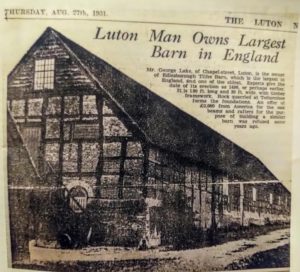TRS main offices are now in Edlesborough Tythe barn. Edlesborough is a historic village or township in the county of Buckinghamshire.

William the Conquer took the throne of England by force in 1066. Pleased with his new land he decided to milk it for all he could, but no one knew what it was worth or what money could be made out of it, sustainability did not enter into it. To find out what England really could produce William commissioned his scribes, lords and clerks to survey the whole kingdom and record what they found in “The Domesday book”.
Edlesorbough is listed in The Domesday book as owned by Gilbert of Ghent, and has two entries in 1086. The first entry has 26 villagers, 4 smallholders and 10 landless surfs. The second entry mentions 10 villagers and 400 pigs. The whole village and land was valued at £14. Woodlands abounded in the area with sporadic houses and the Chiltern Hills to the south. At this time the churches and monasteries controlled the lands and the church collected tythes from all the people in the parish. The tythes were often 1/10th of the hay, cereal and livestock that was produced on the land. The king and local lords, such as Gilbert of Ghent, would collect money from the sale and use of this produce otherwise known as tithes.
Disputes between kings and the church is the story of English history.

Giant tythe barns were built to store all the produce from the land. The Edlesorbough barn is one of the largest in England and was built in 1496 probably to improve on a previous one. It is possible the church authority built the barn when the church was rebuilt, around the same time as Henry the VIII dissolved the monasteries in 1541. Lands were taken from the church and given to lords on behalf of the king. Maybe more tythes were levied and a bigger barn was required.

The barn is 180 feet long and 30 feet wide and is divided into eight bays and two aisles. It is framed in heavy oak and sits on a stone base. This was common, the picture above gives an idea of it before it was converted to offices. Another possible connection to English history is the holding of assizes or local courts where justice could be seen to be done with an audience. Assizes moved around the country using large buildings, Edlesborough is mentioned twice as holding courts, one held by the king in 14th century and second by the English commonwealth when Cromwell was in charge.
The collecting of tythes by lords and civil authorities in goods did not change entirely to money until the 1850s! It is probable that this is when the barn was moved into private use by the church farm. The barn would have been used for threshing in the large bays and for storage of produce. It is remarkable that it has survived as many similar barns have fallen into disuse and collapsed as the fortunes of agriculture have wavered. There are a few similar barns in the hands of the national trust. Edlesborough Tythe barn is a historic grade 2 listed building, it was converted into offices in recent times and now has a pleasing atmosphere where TRS staff can work.
